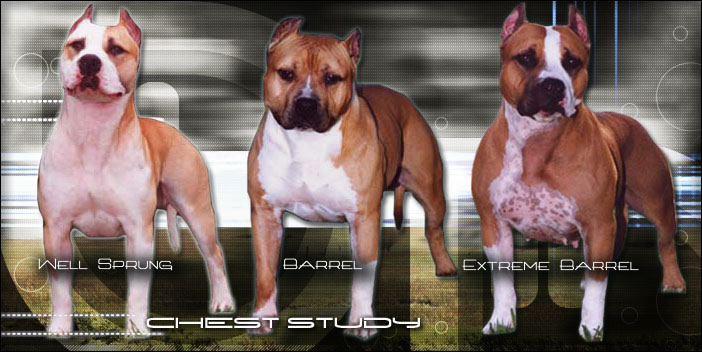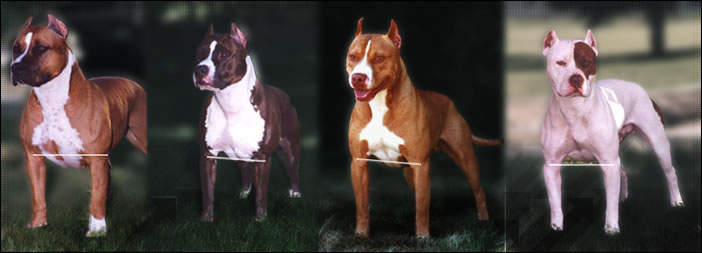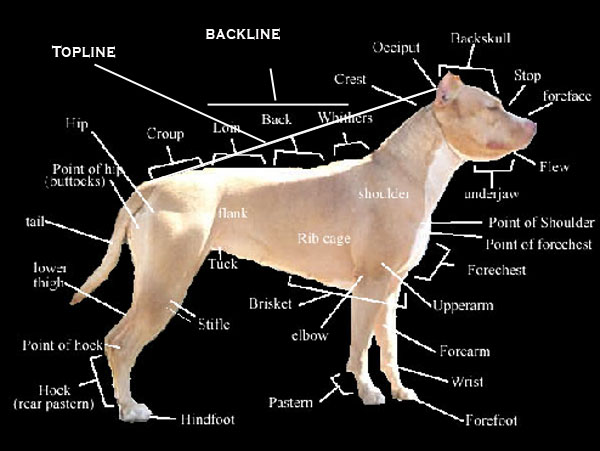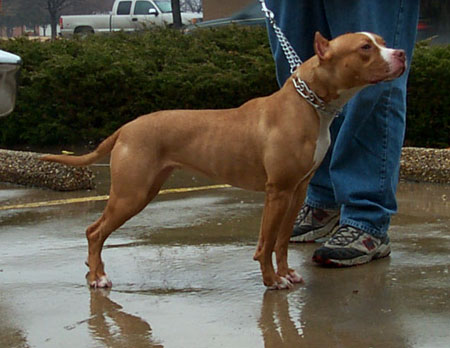Nothing should be over-done or exaggerated.
If you see a dog and think WOW what big muscles or WOW what a huge head this is not correct!
The optimal APBT is a beautiful blend of bull and terrier characteristics.
Nothing should be over-done or exaggerated.
If you see a dog and think WOW what big muscles or WOW what a huge head this is not correct!
The optimal APBT is a beautiful blend of bull and terrier characteristics.
In this section we will focus on that part of the standard that deals with the central body. The body involves many of the key aspects of conformation that drive working functionality. As with all aspects of conformation we must seek to understand that structure which lends success to the working task for which the APBT was designed. The shape of the chest influences many aspects of working type. The APBT needs to be both stable and agile. So a torso that is too narrow does not provide stability and a barrel shaped rib cage dramatically takes away from agility. A shallow rib cage does not move air as effectively as a deep well sprung rib cage. A barrel chest carries excess weight that has no functional benefit. Thus as with all aspects of conformation the APBT is a medium sized, shaped breed that is optimized for maximal performance.
The chest is deep, well filled in, and moderately wide with ample room for heart and lungs, but the chest should never be wider than it is deep. |
The graphic below shows two well-filled in chests (the two dogs in the center). On either end are dogs that have very poor fill (to the left) and overdone or too much fill (on the right). We must strive for moderation and optimization! |
|
The following graphic shows the ratio of width and depth of the chest that is close to optimal. Notice that this chest is also well filled in and extends to the elbows. The width as noted provides a wider base to provide stability to the dog. A very narrow chest would be easily driven sideways by a dog wrestling at the shoulder. However a too wide chest would limit the maneuverability and agility required to change position quickly. the lateral side to side movment and the stability must be optimized to create the perfect image. the chest should never be wider than it is deep. The chest shown here is moderate in width. |
The ribs extend well back and are well sprung from the spine, then flattening to form a deep body extending to the elbows. |
The following graphic shows what is meant by well-sprung. There is considerable problem with the interpretation of well-sprung thus we will hope with this module to give a clear indication. There are basically 3 shapes of chest. There is the barrel chest which is very wrong for an animal that must moderate agility with stability. the English Bulldog is very stable but not very agile. There is the well-sprung rib which is a moderate shape and form. then there is the Deep shaped rib. Thus at the extremes we have the English Bulldog barrel chest and at the other end of the spectrum we have the Gray Hounds very Deep and narrow chest. In essence this is one of the more important aspects of APBT conformation and one which has been dramaticaly neglected especially in the UKC and AKC. Breeders are seeking the more Bulldoggy look and forsaking the truth of well-sprung and flattening to a deep body. The graphic below shows the spectrum we typically see these days in the UKC show ring. On the left is a nice moderate well-sprung rib, in the middle, and as with the overwhelming majority of animals we are beginning to see at shows, gives an example of a barrel, and at the far right we see an extreme barrel chest. THis extreme shape is more appropirate for Old English Bulldogs and bulldoggues. The rational for a well-sprung rib that flattens to a deep chest is related, as noted above, to the need for both dexterity (side to side lateral movement) and the need for an efficient ventilation system. the depth of the chest is vital to the ability of the dog to efficiently transport oxygen to the muscles. If the chest is shallow there is less volume of air moved with each breath. the deeper chests (within reason) provide more volume, which in turn allows more oxygen exchange within the lungs. Without efficient gas exchage in a working dog the muscles will not recieve enough oxygen and during even short burst of energy it can result in the muscles quickly becoming hypoxic. Without enough oxygen being supplied the muscles quickly tire and stop working efficiently. Thus, by selecting for these wide (BIG CHESTS) breeders are short circuiting and dramatically decreasing the working type of the APBT. This is by far one of the most devastating transformations that is occuring in the breed. Barrel chested is BAD! THe APBT should be well-sprung and deep! well sprung from the spine, then flattening to form a deep body |
 |
To give a better visualization the following graphic depicts the three types of chests (barrel, well-sprung, and Deep). As noted in teh standard the APBT blends both well-sprung and Deep. The barrel shaped graphic below is even moderate compared to the barrel and extreme barrel chests visualized in the actual APBT seen above. According to the standard, the APBT should actual be more toward the deep style depicted here. This provides much better room for lung expansion in the chest. It is through the depth of the chest not the width that more air is derived. Think of the lungs as a set of bellows on a forge that expand downward in the chest (not sideways or backward). Without enough depth the APBT loses its ability to effectively exchange oxygen and deliver it to the muscles. Without oxygen in enough quantity delivered to the muscles they become fatigued and anaerobic (hypoxic) much more rapidly. In a dog that depends on muscle strength and stamina this is one of the worse faults that we can introduce in a breeding program. well sprung from the spine, then flattening to form a deep body |
IT is important for the true steward of the breed to gain a well practiced eye that is able to tell the difference between a well-sprung and a deep chest within the APBT. THis is because the APBT by definition should have a "well sprung rib" flattening to form a deep body extending to the elbows. Thus, by definition the APBT should have chest and ribs that are between those of the well-sprung and the deep graphic above. The dog photos below are both well sprung and deep chested. Think moderation and medium. Always remember the APBT is a moderate, medium sized breed. |
extending to the elbows. In the followng graphic we see what is meant by the chest extending to the elbows. Notice the dog on the leg is one of the barrel shaped chests that is also too filled out and indeed also extends beyond the elbows. As we move toward the right we see a dog that is well sprung but is not particularly deep yet does extend to the elbows. The next dog has a wellsprung rib that flattens and extends to the elbows combining well sprung and depth. Finally the dog to the extreme right is well sprung but does not flatten nor extend to the elbows. THus we have a nice display of two moderate well formed ribs (the two center dogs) and two extremes (left OVERDONE, right shallow chested lacking fill) The two middle chest extend to the elbows. The chests on either end are incorrect |
 |
The back is strong and firm. |
The back, just like in humans, is an important aspect of the dog. A weak back results from poor structure and musculature. This typically stems from a structural weakness in the spine and weak musculature. The spine and its muscular support should have enough flexability that it contributes to the agility of the dog but enough firmness that it provides strength and stability. |
 |
The topline inclines very slightly downward from the withers to a broad, muscular, level back. |
Also notice the graphic above and the difference between topline and backline. The topline is typically measured as visualized above though within the APBT standard this has been indicated to say that we need to look from whithers to backline and that their should be a very slight incline . Visit the Topline study page to gain a better understanding of how to evaluate toplines The following graphic shows 3 types of toplines. A very nice topline that has a slight incline from whithers to a broad, muscular level back. and two that have poor structure. Gaining an eye for what a functional APBT back is like is half the battle. There is an overabundance of short, close coupled animals these days. These dogs have the broad muscular aspect but have lost the agility and flexibility needed (REMEMBER OPTIMIZATION OF STRENGTH< SPEED < AGILITY) This graphic shows a sway backed topline to the left, a gorgeous topline in the center, and a terribly roached topline to the right. |
 |
The loin is short, muscular and slightly arched to the top of the croup, but narrower than the rib cage and with a moderate tuck-up |
 |
(TUCK UP IS VERY IMPORTANT IN AN ATHLETIC DOG AND THE DEGREE OF TUCK IS INDICATIVE OF THE LEVEL OF CONDITIONING. THE LOCATION OF THE TUCK IS INDICATED IN THE FIGURE BELOW) . |
T he croup is slightly sloping downward. |
Nothing nothing nothing nothing should be over-done or exaggerated.
To Learn more about related structure after visiting this page visit the following pages |
IF you have additional questions or want concepts better explained contact us at the APBT network forum. A FRIENDLY COMMUNITY of teachers who are students and students who are teachers. Come by to learn AND to teach! We need and welcome you http://www.ukcpitbull.com/pit |